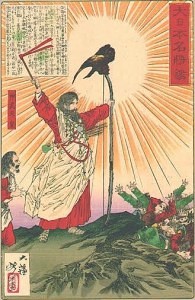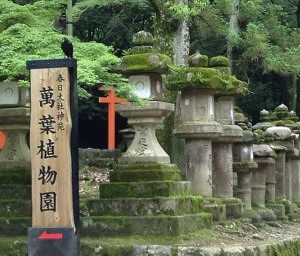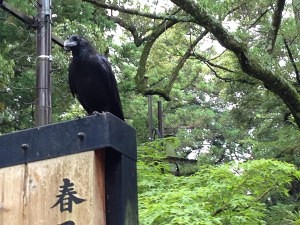Today I am super stoked to share a guest post from the lovely Susan Spann. Susan’s newest book, FLASK OF THE DRUNKEN MASTER came out just this week so I invited her to visit my blog to talk about it. She did even better that–this post has corvids! Whoot! It’s almost like she knows the way to my heart or something 😉
Following the Eight-Span Crow
by Susan Spann
 Western legends often portray the crow as a harbinger of disaster, lurking about like Poe’s raven to observe the misfortunes of man.
Western legends often portray the crow as a harbinger of disaster, lurking about like Poe’s raven to observe the misfortunes of man.
In Japan, the crow is more often seen as evidence of positive divine intervention in human affairs. The Shinto pantheon even includes a crow god, Yatagarasu (“the eight-span crow”), who symbolizes guidance. A crow’s appearance portends rebirth, new growth, and supernatural guidance. According to the Kojiki (Japan’s oldest historical record), the eight-span crow led Jimmu, a human descendant of the sun goddess Amaterasu, to the site where he assumed the throne and became the first Emperor of Japan.
I recently traveled to Japan to research the next few books in my Shinobi Mystery series (and also another novel I’m now writing on the side). Crows play a significant role in one of the upcoming mysteries, and I hoped to see a Japanese crow (Corvus macrorhynchos, also known as the Jungle Crow or Large-Billed crow) on my travels.
Little did I know that Yatagarasu also had something special in store for me…
On my second day in Kyoto, I visited Fushimi Inari Taisha, one of Japan’s most important Shinto shrines, and a location which features prominently in one of my upcoming novels. The shrine consists of buildings at the base of Mount Inari and a path that winds up the side of the mountain to another shrine at the very top. The climb takes several hours, so many people don’t do the entire thing, but I wanted the full experience, so up I went…alone.
The primary path up the mountain is lined with thousands of torii gates, which represent the passage from the worldly to a sacred space.
A little way up the mountain, a path branches off from the main one. Visitors who opt to follow the “road less taken” are rewarded by a sub-shrine with statues memorializing the dragon guardians of Japan (fascinating, but a subject for another post).
Another, ev en less traveled path, leads out and away from this sub-shrine, through a primeval bamboo grove. I knew I had a long hike ahead, but I couldn’t resist the temptation to follow the bamboo path for a little while.
en less traveled path, leads out and away from this sub-shrine, through a primeval bamboo grove. I knew I had a long hike ahead, but I couldn’t resist the temptation to follow the bamboo path for a little while.
Ten minutes later, deep in the heart of an undisturbed primeval forest, I heard a flutter of wings and found myself face to face with a giant black crow. It landed not three feet away, on the side of the path, and looked at me with absolutely no fear. We stared at each other for several minutes—me, memorizing his every detail, and him apparently hoping I’d offer a handout (I didn’t…but only because I had nothing with me he’d want).
The crow showed no concern about me, but flew away when it heard another couple approaching along the path. They saw it leave—and seemed disappointed that the giant bird didn’t stay long enough for them to get a photograph. I continued up the mountain without telling them that it had stayed for me.
Several days later, I visited Kasuga Taisha, another major Shinto shrine (and, not surprisingly, the setting for another upcoming book). As I approached the entrance, a giant crow swooped down and landed on the entry post. Like the one at Fushimi Inari (over a hundred miles away) he watched me approach and waited for me to come and stand beside him.
Japanese crows, like their brethren around the world, are confident birds with little fear of people. It’s common to see them at Shinto shrines and they often watch the visitors with interest.
Even so, I couldn’t help but feel that the crows at Fushimi Inari and Kasuga—and others I continued to see at critical moments throughout the trip—appeared as a special, and positive, sign that my travels and my writing are taking me in the right direction.
I’m not superstitious by nature, but after my eerily timely encounters with Japanese crows, I absolutely understand why Japanese legend says the crow is a wise and benevolent sign of heaven’s favor. I was honored to have them “leading” me through my travels in Japan.

Susan Spann writes the Shinobi Mysteries, featuring ninja detective Hiro Hattori and his Portuguese Jesuit sidekick, Father Mateo. Her third novel, FLASK OF THE DRUNKEN MASTER, released on July 14, 2015. When not writing or practicing law, she raises seahorses and rare corals in her marine aquarium. You can find her online at http://www.SusanSpann.com, on Twitter (@SusanSpann), and on Facebook (SusanSpannAuthor), where she regularly blogs about Japan, publishing law, and seahorses.
[Text and Photographs © 2015 Susan Spann]

